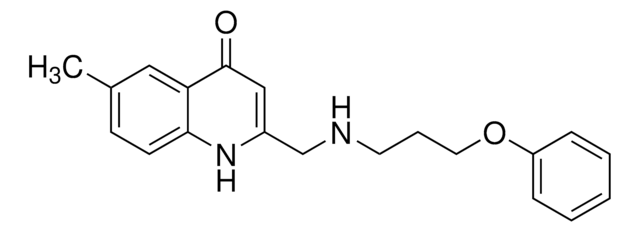SRP3317
ANGPTL-3 human
recombinant, expressed in CHO cells, ≥98% (SDS-PAGE), ≥98% (HPLC)
Sinónimos:
ANG-5, ANGPT5
Iniciar sesiónpara Ver la Fijación de precios por contrato y de la organización
About This Item
Código UNSPSC:
12352202
NACRES:
NA.32
Productos recomendados
origen biológico
human
recombinante
expressed in CHO cells
Análisis
≥98% (HPLC)
≥98% (SDS-PAGE)
formulario
lyophilized
mol peso
62.0 kDa
envase
pkg of 50 μg
impurezas
endotoxin, tested
color
white to off-white
Nº de acceso UniProt
Condiciones de envío
wet ice
temp. de almacenamiento
−20°C
Información sobre el gen
human ... ANGPTL3(27329)
Descripción general
ANGPTL-3 (Angiopoietin like protein 3) is a member of the angiopoietin family of structurally related proteins, characterized by a coiled N-terminal domain and a C-terminal fibrinogen like domain. It is mainly present in the hepatocytes and is also secreted into circulation. The gene is mapped to human chromosome 1p31.
Recombinant human ANGPTL-3 is a glycoprotein that migrates by SDS-PAGE (sodium dodecyl sulfate polyacrylamide gel electrophoresis) analysis at an apparent molecular weight of 62kDa, and contains 452 amino acid residues including a C-terminal His tag.
Recombinant human ANGPTL-3 is a glycoprotein that migrates by SDS-PAGE (sodium dodecyl sulfate polyacrylamide gel electrophoresis) analysis at an apparent molecular weight of 62kDa, and contains 452 amino acid residues including a C-terminal His tag.
Acciones bioquímicas o fisiológicas
ANGPTL-3 (Angiopoietin like protein 3) can exert activities related to both angiogenesis and lipid metabolism. ANGPTL-3 inhibits lipoprotein lipase (LPL) and endothelial lipase (EL), which has the effect of increasing plasma levels of triglycerides and HDL (high-density lipoprotein)-associated cholesterol. The fibrinogen like portion of the ANGPTL-3 protein can bind α-5/β-3 integrins leading to endothelial cell adhesion and migration. Mutations in this gene can result in familial combined hypobetalipoproteinemia.
Forma física
Lyophilized from 10mM Sodium Phosphate, pH 7.5.
Reconstitución
Centrifuge the vial prior to opening. Reconstitute in water to a concentration of 0.1-1.0 mg/ml. Do not vortex. This solution can be stored at 2-8°C for up to 1 week. For extended storage, it is recommended to further dilute in a buffer containing a carrier protein (example 0.1% BSA) and store in working aliquots at -20°C to -80°C.
Código de clase de almacenamiento
11 - Combustible Solids
Clase de riesgo para el agua (WGK)
WGK 3
Punto de inflamabilidad (°F)
Not applicable
Punto de inflamabilidad (°C)
Not applicable
Certificados de análisis (COA)
Busque Certificados de análisis (COA) introduciendo el número de lote del producto. Los números de lote se encuentran en la etiqueta del producto después de las palabras «Lot» o «Batch»
¿Ya tiene este producto?
Encuentre la documentación para los productos que ha comprado recientemente en la Biblioteca de documentos.
ANGPTL3 stimulates endothelial cell adhesion and migration via integrin alpha vbeta 3 and induces blood vessel formation in vivo.
Camenisch G, et al.
The Journal of Biological Chemistry, 277, 17281-17281 (2002)
Post-GWAS methodologies for localisation of functional non-coding variants: ANGPTL3.
Oldoni F, et al.
Atherosclerosis, 246, 193-193 (2016)
Circulating angiopoietin-like protein 8 (ANGPTL8) and ANGPTL3 concentrations in relation to anthropometric and metabolic profiles in Korean children: a prospective cohort study.
Chung HS, et al.
Cardiovascular Diabetology, 15, 1-1 (2016)
Mohamed Abu-Farha et al.
Lipids in health and disease, 15(1), 181-181 (2016-10-14)
Hypertriglyceridemia is associated with increased risk for cardiovascular diseases and type 2 diabetes (T2D). Angiopoietin like proteins particularly 3, 4 and recently 8 are well established regulators of plasma triglyceride level through regulating the activity of lipoprotein lipase. Plasma level
Dong Zhao et al.
Cardiovascular diabetology, 15(1), 132-132 (2016-09-14)
Angiopoietin-like protein 3 (ANGPTL3) is a major lipoprotein regulator and shows positive correlation with high-density lipoprotein-cholesterol (HDL-c) in population studies and ANGPTL3 mutated subjects. However, no study has looked its correlation with HDL components nor with HDL function in patients
Nuestro equipo de científicos tiene experiencia en todas las áreas de investigación: Ciencias de la vida, Ciencia de los materiales, Síntesis química, Cromatografía, Analítica y muchas otras.
Póngase en contacto con el Servicio técnico